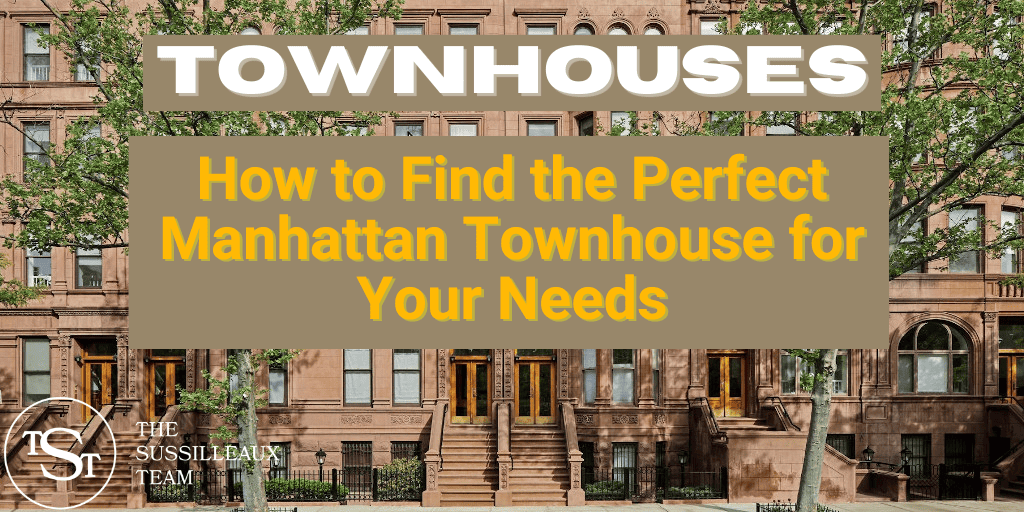Understanding Manhattan Townhouse Styles and Neighborhoods
Common Architectural Styles
Manhattan townhouses are known for their diverse and historically rich architectural styles. Among the most common styles you’ll encounter are:
Federal, Greek Revival, and Italianate
Federal style townhouses date back to the late 18th and early 19th centuries. They are characterized by simple, symmetrical facades and delicate ornamentation. Greek Revival and Italianate styles followed, with the former featuring grand columns and pediments reminiscent of ancient Greek temples, and the latter showcasing decorative brackets and cornices inspired by Italian Renaissance architecture.
Second Empire, Beaux-Arts, and Neo-Grec
Second Empire townhouses boast mansard roofs and elaborate, often asymmetrical, facades. Beaux-Arts style, popular in the late 19th and early 20th centuries, exudes grandeur with its classical details and lavish ornamentation. Neo-Grec townhouses, on the other hand, present a more restrained and geometric approach to ornamentation, often with incised stonework and angular forms.
Popular Manhattan Neighborhoods for Townhouses
Manhattan is home to numerous neighborhoods, each with its own distinct charm and architectural offerings. Some of the most popular neighborhoods for townhouse buyers include:
Upper East Side, Upper West Side, and Greenwich Village
The Upper East Side and Upper West Side both feature elegant townhouses in a variety of styles. These neighborhoods are known for their tree-lined streets, prestigious schools, and upscale dining and shopping options. Greenwich Village, with its cobblestone streets and bohemian vibe, offers a unique blend of historic townhouses and vibrant cultural attractions.
SoHo, Chelsea, and Harlem
SoHo is renowned for its cast-iron architecture and chic, loft-style living spaces. Chelsea, with its art galleries and High Line Park, boasts an eclectic mix of townhouses and modern buildings. Harlem is experiencing a renaissance, with beautifully restored townhouses that showcase its rich history and cultural legacy.
Establishing Your Priorities and Preferences
When searching for the perfect Manhattan townhouse, it’s essential to identify your priorities and preferences. Consider the following factors:Location and Proximity to Amenities
Think about your daily needs and lifestyle preferences. Do you want to be near top-rated schools, parks, or cultural institutions? Consider a neighborhood that aligns with your interests and offers easy access to the amenities you value most.
Architectural Style and Historic Significance
Are you drawn to a specific architectural style or period? Do you prefer a historic townhouse with original details or a modernized home with contemporary finishes? Identifying your aesthetic preferences will help narrow down your search.
Size and Number of Bedrooms
Determine how much space you need, including the number of bedrooms and bathrooms, and prioritize homes that meet your requirements.
Outdoor Space and Private Gardens
If outdoor living is important to you, prioritize townhouses with private gardens, rooftop terraces, or balconies.
Condition and Renovation Potential
Assess whether you’re willing to undertake a renovation project or prefer a move-in-ready home. Consider the costs and time involved in any necessary upgrades.
The Trade-Offs When Buying a Townhouse
In the pulsating heart of Manhattan, a townhouse is more than a mere dwelling; it’s a piece of New York history, a symbol of status, and a comforting refuge amidst the city’s constant bustle. Yet, as prospective homeowners embark on the journey of finding the perfect Manhattan townhouse for their needs, they’ll inevitably encounter various trade-offs. The following paragraphs will shed light on these compromises to ensure buyers are adequately prepared to make informed decisions.
Location vs. Space
Manhattan, known for its coveted addresses and sky-high real estate prices, presents the classic trade-off of location versus space. Owning a townhouse in a prime location, like the Upper East Side or SoHo, often means sacrificing square footage or outdoor space due to the premium prices in these neighborhoods. On the other hand, more affordable townhouses can be found in emerging neighborhoods like Harlem or the Lower East Side. The challenge lies in striking a balance between a desirable location and the desired space, while also keeping in mind other aspects like nearby amenities, noise levels, and commuting distances.
Historic Charm vs. Modern Comfort
Manhattan’s townhouses are replete with historic charm, many reflecting architectural styles dating back to the 19th and early 20th centuries. While the allure of living in a historic property is undeniable, it often comes with a trade-off of modern comforts. Old-world construction might mean smaller windows, fewer bathrooms, less efficient heating and cooling systems, and a lack of certain contemporary features like open-plan living spaces or adequate electrical outlets. Buyers must consider their willingness to trade the charm and character of a historic home for the convenience and efficiency of a modern one, or vice versa.
Maintenance and Renovation Costs
Maintenance and renovation are other critical factors to consider. The upkeep of a Manhattan townhouse, especially a historic one, can be a significant ongoing cost. Aging infrastructure may require extensive and expensive renovations to modernize. Plus, if the townhouse is located in a designated historic district, there are strict guidelines and regulations for renovations, often necessitating more expensive materials and processes. On the flip side, more modern or recently renovated townhouses may have fewer maintenance needs and allow for more freedom in customization, but they can also come with a higher upfront cost.
Single-Family vs Multi-Family Townhouses
Another crucial consideration when buying a Manhattan townhouse is choosing between a single-family or a multi-family dwelling. Single-family townhouses offer more privacy, control over the entire property, and the freedom to customize and modify the home to your heart’s content. However, these come with a heftier price tag and the full responsibility for upkeep and repairs. In contrast, multi-family townhouses, which have been divided into separate apartments, can provide a source of rental income to offset mortgage payments and maintenance costs. This option can be financially beneficial but entails being a landlord, with the accompanying responsibilities and potential complexities. Deciding between these options depends on a buyer’s financial goals, desired level of responsibility, and need for privacy.
Summary of Trade-Offs
Finding the perfect Manhattan townhouse for your needs is a complex process, involving many trade-offs and considerations. While daunting, this journey is also incredibly rewarding, potentially leading you to a slice of New York history to call your own. By understanding these trade-offs, prospective buyers can make informed decisions and find a townhouse that balances their needs, wants, budget, and dreams, making their Manhattan home truly perfect for them.
Navigating the Manhattan Townhouse Market
Working with a Knowledgeable Real Estate Agent
A real estate agent with expertise in the Manhattan townhouse market will help guide you through the buying process, from identifying suitable properties to negotiating the best price. They can also provide invaluable insight into market trends and neighborhood-specific nuances.
Researching Comparable Sales and Market Trends
To get a sense of the current market and what you can expect to pay for a townhouse in your desired neighborhood, research comparable sales and market trends. Your real estate agent can provide you with this information, helping you make an informed decision on your budget and negotiation strategy.
Attending Open Houses and Private Showings
Your broker can arrange visiting open houses and scheduling private showings so you can see some properties first-hand. Understanding what’s out there is a crucial part of the home-buying process. This allows you to see the features and condition of each townhouse, assess its suitability, and envision yourself living there.
Financial Considerations for Manhattan Townhouse Buyers
Determining Your Budget
Before beginning your search, establish a realistic budget based on your financial situation and the current market. Be sure to account for additional costs such as closing fees, moving expenses, and ongoing maintenance.
Exploring Financing Options
There are several financing options available for townhouse buyers. Some of the most common include:
Conventional Loans and Jumbo Loans
Conventional loans are backed by private lenders and follow guidelines set by Fannie Mae and Freddie Mac. Jumbo loans, on the other hand, exceed the conforming loan limits set by these agencies and are designed for higher-priced properties, such as luxury townhouses.
Adjustable-Rate Mortgages and Fixed-Rate Mortgages
Adjustable-rate mortgages (ARMs) have interest rates that change periodically, while fixed-rate mortgages maintain the same interest rate throughout the loan term. Weigh the pros and cons of each type of mortgage to determine which is best for your financial situation.
Understanding Closing Costs and Taxes
Be prepared for closing costs, which can include attorney fees, transfer taxes, title insurance, and mortgage-related expenses. Additionally, Manhattan townhouse owners are responsible for property taxes, which can vary based on the property’s assessed value and location.
Making an Offer and Closing the Deal
Preparing a Competitive Offer
Once you’ve found the perfect townhouse, work with your real estate agent to craft a competitive offer that takes into account the property’s condition, recent sales, and market trends.
Negotiating with Sellers
Negotiations are common in the Manhattan townhouse market. Be prepared to make concessions or counteroffers based on the seller’s response to your initial offer.
Home Inspections and Appraisals
Before signing a contract of sale, it’s essential to schedule a home inspection to identify any potential issues or needed repairs. Your lender will also require a property appraisal to determine the townhouse’s market value and ensure the loan amount is appropriate.
Closing Process and Moving In
Once your offer is accepted, you’ll work with your real estate agent, attorney, and lender to complete the closing process, which includes finalizing your mortgage, signing documents, and transferring the title. After closing, you can begin the exciting process of moving into your new Manhattan townhouse.
Conclusion
Finding the perfect Manhattan townhouse for your needs involves understanding architectural styles and neighborhoods, establishing priorities, navigating the market, and considering financial factors. By working with experienced professionals and carefully weighing your options, you’ll be well on your way to owning the townhouse of your dreams.
Further Reading
You can return to The Complete Guide to Manhattan Townhouses, go to the preceding article; The Unique Features of Manhattan Townhouses or read the next article in the series: Manhattan Townhouse Pricing: What to Expect and How to Negotiate
Frequently Asked Questions (FAQs)
- What is the typical price range for a Manhattan townhouse?
- How do I determine if a Manhattan townhouse is located in a landmark district or has landmark status?
- Can I purchase a Manhattan townhouse as an investment property?
- What are the ongoing maintenance responsibilities of owning a Manhattan townhouse?
- Are there any special considerations when purchasing a historic Manhattan townhouse?
What is the typical price range for a Manhattan townhouse?
The price range for Manhattan townhouses can vary widely based on location, size, architectural style, and condition. Townhouses can range from a few million dollars to tens of millions for luxury properties in prime neighborhoods.
How do I determine if a Manhattan townhouse is located in a landmark district or has landmark status?
To find out if a townhouse is located in a landmark district or has landmark status, consult the New York City Landmarks Preservation Commission (LPC) website or consult with your real estate agent. Landmark status or location in a historic district can impact renovation possibilities and may require approval from the LPC for any exterior alterations.
Can I purchase a Manhattan townhouse as an investment property?
Yes, many buyers choose to purchase Manhattan townhouses as investment properties. These properties can serve as rental units or be renovated and resold for a profit. However, keep in mind that managing an investment property comes with additional responsibilities and expenses, such as maintenance, taxes, and insurance.
What are the ongoing maintenance responsibilities of owning a Manhattan townhouse?
Owning a Manhattan townhouse comes with ongoing maintenance responsibilities, such as regular upkeep, repairs, and improvements. This can include tasks like cleaning gutters, repairing or replacing roofing, repointing brickwork, and maintaining heating and cooling systems. Additionally, historic townhouses may require specialized care to preserve original features and materials.
Are there any special considerations when purchasing a historic Manhattan townhouse?
When purchasing a historic Manhattan townhouse, you must consider the following::
- Renovation restrictions: If the townhouse has landmark status or is located in a historic district, you may need to obtain approval from the LPC for any exterior alterations.
- Preservation of original features: Many historic townhouses feature unique architectural details that require specialized care and preservation efforts.
- Energy efficiency: Older townhouses may not be as energy-efficient as newer properties, so you may need to invest in upgrades to improve insulation, windows, and heating and cooling systems.
- Structural integrity: Be prepared to address any structural issues that may arise in older properties, such as foundation problems, water damage, or outdated electrical and plumbing systems.





